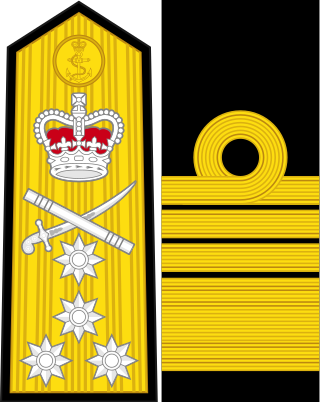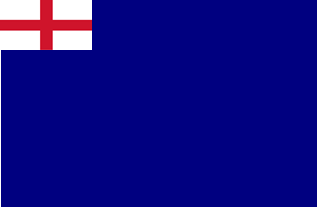
Admiral of the Fleet Edward Russell, 1st Earl of Orford, PC was a Royal Navy officer and politician. After serving as a junior officer at the Battle of Solebay during the Third Anglo-Dutch War, he served as a captain in the Mediterranean Sea in operations against the Barbary pirates.

Admiral is a senior rank of the Royal Navy, which equates to the NATO rank code OF-9, outranked only by the rank of admiral of the fleet. Royal Navy officers holding the ranks of rear admiral, vice admiral and admiral of the fleet are sometimes considered generically to be admirals. The rank of admiral is currently the highest rank to which a serving officer in the Royal Navy can be promoted, admiral of the fleet being in abeyance except for honorary promotions of retired officers and members of the Royal Family.

The Fourth Sea Lord and Chief of Naval Supplies originally known as the Fourth Naval Lord was formerly one of the Naval Lords and members of the Board of Admiralty which controlled the Royal Navy of the United Kingdom the post is currently known as Chief of Materiel (Fleet). As of 2017, it is also known as Chief of Fleet Support, Chief of Materiel (Ships) then as of 2020, Director General Ships.

The Lieutenant of the Admiralty is a now honorary office generally held by a senior retired Royal Navy admiral. He is the official deputy to the Vice-Admiral of the United Kingdom. He is appointed by the Sovereign on the nomination of the First Sea Lord.

The First Lord of the Admiralty, or formally the Office of the First Lord of the Admiralty, was the political head of the English and later British Royal Navy. He was the government's senior adviser on all naval affairs, responsible for the direction and control of the Admiralty, and also of general administration of the Naval Service of the Kingdom of England, Great Britain in the 18th century, and then the United Kingdom, including the Royal Navy, the Royal Marines, and other services. It was one of the earliest known permanent government posts. Apart from being the political head of the Naval Service the post holder was simultaneously the pre-eminent member of the Board of Admiralty. The office of First Lord of the Admiralty existed from 1628 until it was abolished when the Admiralty, Air Ministry, Ministry of Defence and War Office were all merged to form the new Ministry of Defence in 1964. Its modern-day equivalent is the Secretary of State for Defence.
John Godolphin (1617–1678) was an English jurist and writer, and Judge of the High Court of Admiralty under the Commonwealth.

The Cinque Ports Fleet was the a temporary formation of ships supplied to the crown from the Confederation of the Cinque Ports for particular naval expeditions during particular campaigns of the Kingdom of England from 1260 to 1558.

The Lord High Admiral of the United Kingdom is the ceremonial head of the Royal Navy. Most have been courtiers or members of the British royal family, and not professional naval officers. The Lord High Admiral is one of the nine English Great Officers of State and since 2021 is held personally by the reigning monarch.

The Admiralty and Marine Affairs Office (1546–1707), previously known as the Admiralty Office (1414–1546), was a government department of the Kingdom of England, responsible for the Royal Navy. First established in 1414 when the offices of the separate Admiral of the North and West were abolished and their functions unified under a single centralised command, it was headed by the Lord High Admiral of England. The department existed until 1707 when England and Scotland united to form the Kingdom of Great Britain, after which it was known as the British Admiralty.

During the early 17th century, England's relative naval power deteriorated; in the course of the rest of the 17th century, the office of the Admiralty and Marine Affairs steered the Navy's transition from a semi-amateur Navy Royal fighting in conjunction with private vessels into a fully professional institution, a Royal Navy. Its financial provisions were gradually regularised, it came to rely on dedicated warships only, and it developed a professional officer corps with a defined career structure, superseding an earlier mix of sailors and socially prominent former soldiers.

The Commander-in-Chief, North Sea, was senior appointment and an operational command of the British Royal Navy originally based at Great Yarmouth from 1745 to 1802 then at Ramsgate from 1803 until 1815.

The Clerk of the Acts, originally known as the Keeper of the King's Ports and Galleys, was a civilian officer in the Royal Navy and a principal member of the Navy Board. The office was created by King Charles II in 1660 and succeeded the earlier position of Clerk of the Navy(1546 to 1660). The Clerk was responsible for the organisation of Navy Office, processing naval contracts and coordinating the administrative and secretarial side of the Navy Board's work. The post lasted until 1796, when its duties were merged with that of the Second Secretary to the Admiralty later known as the Permanent Secretary to the Admiralty.

The Admiral of the North also known as Admiral of the Northern Seas and Admiral of the Northern Fleet was a senior English Navy appointment. The Admiral was chiefly responsible for the command of the navy's fleet that operated in the North Sea and off the English coast out of Yarmouth from 1294 to 1412.

The Admiral of the North and West or Admiral of the North and Western Fleets was a former senior appointment of the English Navy. The post holder was Commander-in-Chief of the English navy's North and Western Fleets operating in the North Sea, the English Channel, the Southern Irish Sea and Atlantic from 1364 to 1414.

Admiral Sir William de Leybourne, was an English Knight and Military Commander.

The Admiral of the South also known as Admiral of the Southern Fleet was a senior English Navy appointment. The post holder was chiefly responsible for the command of the navy's fleet that operated in the English Channel out of Portsmouth from 1294 to 1326.

The Admiral of the South, North and West formally known as Admiral of the King's Southern, Northern and Western Fleets or Admiral of all the Fleets about England was a senior English Navy appointment and Commander-in-Chief of the English Navy from 1360 to 1369.

The Irish Squadron originally known as the Irish Fleet was a series of temporary naval formations assembled for specific military campaigns of the English Navy, the Navy Royal and later the Royal Navy from 1297 to 1731.











